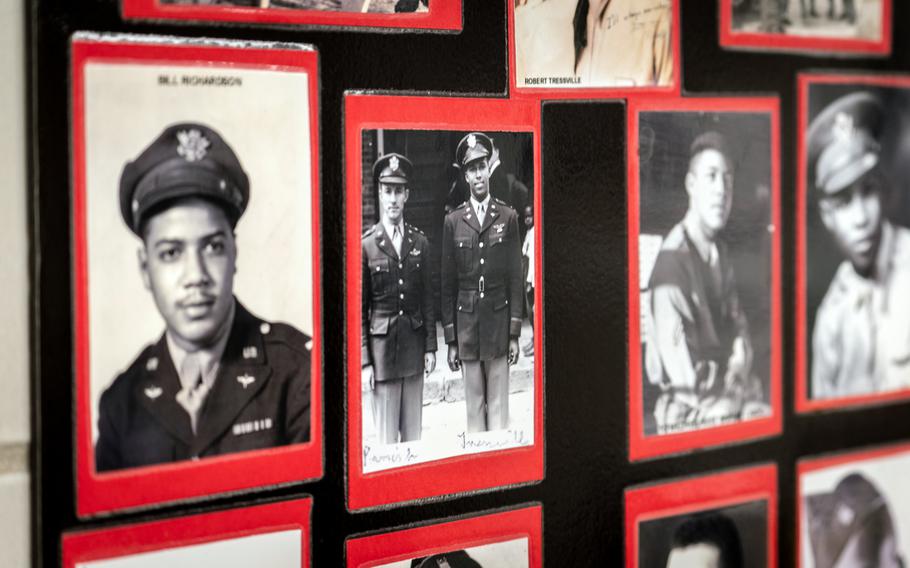
The Tuskegee Airmen were America’s first Black military flyers. They took to the skies in P-47 Thunderbolt, P-51 Mustang and other fighter aircraft to escort bombers on dangerous missions over Germany in World War II. (Wikimedia Commons)
Harry S. Stewart Jr., a fighter pilot with the Tuskegee Airmen who earned the Distinguished Flying Cross for three kills in a single mission, died Sunday in Bloomfield Hills, Mich. He was 100.
Stewart was one of the few remaining veterans who flew with the all-Black Tuskegee Airmen in World War II, during which troops were segregated by race.
Stewart died “peacefully” in his home, the Tuskegee Airmen National Historical Museum said in a Facebook post Monday announcing his death.
“Harry Stewart was a kind man of profound character and accomplishment with a distinguished career of service he continued long after fighting for our country in World War II,” Brian Smith, the museum’s president and CEO, said in the Facebook post.
The first black airmen completed flight training at their namesake Tuskegee Army Air Field in Tuskegee, Ala., in March 1942.
The Tuskegee Airmen joined the military to fight the Axis powers of Germany and Japan “at a time when there were many people who thought that black men lacked intelligence, skill, courage, and patriotism,” the museum states on its website.
Last month, the Air Force briefly removed information about the Tuskegee Airmen from its basic training curriculum to comply with a crackdown by President Donald Trump administration’s on diversity, equity and inclusion initiatives. The service on Jan. 27 reinstated the lessons, including videos, that pertained to the groundbreaking Black aviators and the Women Airforce Service Pilots, who ferried military aircraft during World War II, after Sen. Katie Britt, R-Ala., raised an objection via a post on social platform X.
Stewart was born July 4, 1924, in Newport News, Va., and his family moved to New York state when he was young, Stewart said in a Jan. 14, 2019, interview with the American Veterans Center.
He was fascinated with flying as he grew up, following the exploits of famed aviators such as Charles Lindberg and Amelia Earhart.
“I vowed at a very early age that I’d try my best to become a pilot and maybe fly in the airlines when I had grown up,” he said in the interview. “The war came along, and it so happened I was lucky enough to pass the exam for the Aviation Cadet Corps and went to Tuskegee Army flying school.”
“As a youngster of 18-years-old I was wide-eyed and awestruck by all of the things I saw,” he said of flight school.
He was later stationed in South Carolina to train in a fighter plane, and in November 1944 he was sent to Italy to escort bombing missions.
There he flew 43 combat missions with the 332nd Fighter Group, dubbed the Tuskegee Airmen. He flew evolving versions of the P-51, he said.
He was credited with three “kills” during a single mission, a feat matched by only three other Tuskegee Airmen during the war.
“I shot down two aircraft, and a third one I was given credit for,” Stewart said in the interview, seeming almost embarrassed about bring credited for the third kill.
“I surprised the two that I shot down there, but then I saw these tracers from the one behind me,” he said. “I thought for sure I was going to get hit and knocked down by that one. But fortunately, he either over-controlled or had some sort of problem because he went into the ground. I was home free at that time.”
He was awarded the Distinguished Flying Cross for his actions that day.
Steward was among the three-man Tuskegee Airmen team that took the top award at the Air Force’s Top Gun competition in 1949.
Teams were chosen from 12 U.S. fighter groups. The groups were divided into those who flew jets and those who piloted piston-engine fighters.
“We won the team score out of all of the people in the piston group,” he said.
“It was quite a feather in our cap as far as the 332nd was concerned,” he said. “I think it put an end to any doubt in people’s minds as far as the ability of the Tuskegee Airmen were concerned.”
He left active duty in 1950 but continued to serve in the U.S. Air Force Reserves, where he retired with the rank of lieutenant colonel.
He went on to earn a degree in mechanical engineering and became vice president at ANR Pipeline Company in Detroit.